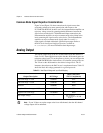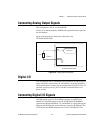
Chapter 2 Hardware Overview of the NI 78xxR
R Series Intelligent DAQ User Manual 2-18 ni.com
NI 7830R has one RMIO and one RDIO connector for a total of 56 DIO
lines. The NI 7831R/7833R/784xR/785xR has one RMIO and two RDIO
connectors for a total of 96 DIO lines.
Refer to Figure A-1, NI 781xR Connector Pin Assignments and Locations,
for the connector locations and the I/O connector pin assignments on the
NI 781xR. Refer to Figure A-2, NI 783xR/784xR/785xR Connector Pin
Assignments and Locations, for the connector locations and the I/O
connector pin assignments on the NI 783xR/784xR/785xR.
The DIO lines on the NI 78xxR are TTL-compatible. When configured as
inputs, they can receive signals from 5 V TTL, 3.3 V LVTTL, 5 V CMOS,
and 3.3 V LVCMOS devices. When configured as outputs, they can send
signals to 5 V TTL, 3.3 V LVTTL, and 3.3 V LVCMOS devices. Because
the digital outputs provide a nominal output swing of 0 to 3.3 V
(3.3 V TTL), the DIO lines cannot drive 5 V CMOS logic levels.
To interface to 5 V CMOS devices, you must provide an external pull-up
resistor to 5 V. This resistor pulls up the 3.3 V digital output from the
NI 78xxR to 5 V CMOS logic levels. Refer to the NI R Series Intelligent
DAQ Specifications, available at
ni.com/manuals, for detailed DIO
specifications.
Caution Exceeding the maximum input voltage ratings, listed in Table A-2, NI 78xxR I/O
Signal Summary, can damage the NI 78xxR and the computer. NI is not liable for any
damage resulting from such signal connections.
Caution Do not short the DIO lines of the NI 78xxR directly to power or to ground. Doing
so can damage the NI 78xxR by causing excessive current to flow through the DIO lines.
You can connect multiple NI 78xxR digital output lines in parallel to
provide higher current sourcing or sinking capability. If you connect
multiple digital output lines in parallel, your application must drive all of
these lines simultaneously to the same value. If you connect digital lines
together and drive them to different values, excessive current can flow
through the DIO lines and damage the NI 78xxR. Refer to the NI R Series
Intelligent DAQ Specifications, available at
ni.com/manuals, for more
information about DIO specifications. Figure 2-11 shows signal
connections for three typical DIO applications.


















